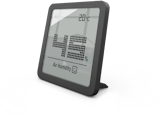Hygrometer
A hygrometer is a measuring device for air humidity and displays the relative humidity in percent. To do this, it measures the ratio of the amount of water vapour in the air in relation to the maximum that the air can absorb – depending on the current room temperature. The hygrometer indicates whether the room climate is too humid, too dry or optimal. Find the right hygrometer for you now and always keep an eye on the relative humidity.
What a digital hygrometer can do for you
Monitors the humidity: A hygrometer measures and displays the current relative humidity so that you can always keep an eye on your indoor climate in the bedroom, children's room, living room, etc. The ideal humidity level is between 40 % and 60 %.

Helps prevent mould growth: By continuously monitoring the humidity, you can detect early on when the humidity rises and take appropriate action before too much moisture builds up.
Supports well-being and health: A hygrometer promotes awareness of a pleasant indoor climate by visualising dryness or humidity so that appropriate measures can be taken immediately.
Promotes energy efficiency: By monitoring humidity, you can better judge when the heating should be used more efficiently, resulting in energy savings.
Facilitates plant care: Plants require specific humidity levels to thrive optimally. A hygrometer helps to monitor and maintain the ideal environment for indoor plants.
Supports the storage of food: In pantries and cellars, a hygrometer can help to monitor the optimum humidity for storing food and thus extend its shelf life.

Helps with wine storage: In wine cellars, humidity control is crucial to protect the corks of the bottles and maintain the quality of the wine. A hygrometer helps to monitor the ideal conditions.

Helps with the storage of musical instruments: Musical instruments such as violins, guitars and pianos can be damaged by humidity levels that are too low or too high. A hygrometer helps to ensure the optimum conditions for their storage.
The world of humidity measurement
Do you want to know more? Or do you want to find out more about why measuring humidity is crucial for maintaining an optimum indoor climate?
On our information page about measuring humidity, we explain why it is important to measure relative humidity, what an ideal humidity value is and the consequences of values that are too high or too low. You will also find out what you can do if the values are too high or too low.

Hygrometer types
Analoge Hygrometer
Analoge Hygrometer nutzen natürliche Materialien wie Haare oder Metallspiralen, die sich je nach Feuchtigkeit ausdehnen oder zusammenziehen. Diese physikalischen Veränderungen bewegen eine Nadel auf einem Ziffernblatt, welche die aktuelle Luftfeuchtigkeit anzeigt.

Advantages
- Easy to use: They do not require batteries and are easy to operate.
- Robustness: Thanks to their simple mechanics, they are less susceptible to damage from falls or knocks.
- Classic design: The classic dial design can look decorative and stylish.
Disadvantages
- Accuracy: Analogue hygrometers tend to be less accurate, with deviations of plus minus 5 % relative humidity or more.
- Readability: The needle and dial require precise interpretation, which is less user-friendly.
- Calibration: Analogue hygrometers must be calibrated manually on a regular basis to ensure accurate readings.
Digitale Hygrometer
Digitale Hygrometer verwenden elektronische Sensoren und Mikroprozessoren zur präzisen Messung der Luftfeuchtigkeit. Die Messergebnisse werden auf einem digitalen Display angezeigt.

Advantages
- High precision: Digital hygrometers provide accurate readings with an accuracy of plus minus 1 % to 3 % relative humidity.
- Legibility: The digital displays are easy to read and often backlit.
- Fast response time: They update and react quickly to changes in humidity.
Disadvantages
- Dependence on batteries: Digital hygrometers require batteries, which means additional effort for replacement.
- Cost: They are generally more expensive than analogue hygrometers, although there are also affordable models.
- Sensitivity: Electronic components can be more susceptible to damage from extreme conditions.





